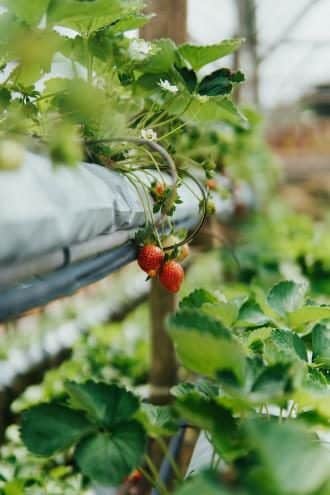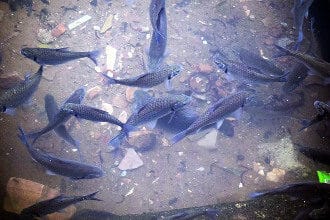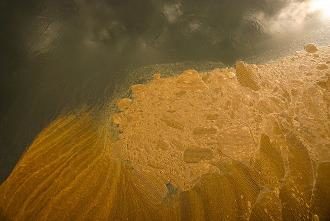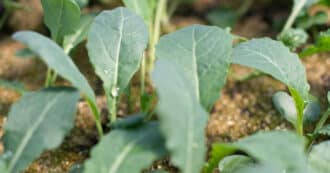By Harry Cooper – Growing plants is an essential part of the modern food system. But unfortunately, many practices used to grow plants and produce food on an industrial scale are inefficient and harmful to the environment.
Modern industrial methods of plant production require extensive water use, harmful chemicals, and large expanses of arable land. As our food production system has grown, these have all become in short supply, but luckily there is a more sustainable alternative.
A Better Way to Grow Plants
Aquaponics systems are a modern method of growing plants that require less water, less added nutrients, and can be installed just about anywhere. Aquaponics systems come in all shapes and sizes, but the basic aquaponics system works by growing plants directly in water and filtering nutrients in from a fish tank.
Aquaponic systems use man made ecosystems to create a more efficient way of growing plants. This method minimizes human involvement in the plant growing process and makes food production all around more efficient.
What Is an Aquaponics System?
Aquaponics is a combination of the two practices of hydroponics systems and aquaculture systems. Hydroponics systems are plant growing systems that use no soil but instead put plant roots directly into water, and aquaculture is the process of raising fish.
Combining hydroponics and fish production through aquaponics creates a mini ecosystem that allows for an incredibly efficient use of nutrients. These aquaponics systems usually require three different parts; a plant growing area, a fish tank, and a biological filtration system.
How The Aquaponics System Works
These three parts work together to make the flow of nutrients run smoothly. The system starts with the only human added nutrient input in the whole process, feeding the fish with fish food.
As the fish eat and process the food, they produce fish waste that is rich in ammonia and other toxic substances. After the fish tank stage, it is time for the waste water to move into the biofiltration tank.
This tank is filled with beneficial bacteria that break down the fish waste into nitrogen and other nutrients. These nutrients are incredibly helpful for plant growth, and are then pumped into the plant growing area to fertilize the plants.
Once the plants have absorbed all the nutrients, the water can then be used in the fish tank once again. Once the water is pumped back into the fish tank the cycle starts back again.
Types of Aquaponics Systems
There are many different types of aquaponic systems. However there are a handful that are typically more well known and more popular.
Nutrient Film Technique
Using a nutrient film technique aquaponic system entails keeping plants in very thin gutters. Nutrient rich water flows in a shallow film across the roots of the plants in order to keep them healthy.
This type of aquaponics system requires a very light weight set up. The best kinds of plants to use with the nutrient film technique are leafy greens or other plants with small root systems.
Media Bed System
A media bed uses plant beds filled with rocks, clay, or a similar material. The water from the biofilter is then pumped over the material to water the plants.
Deep Water Culture Technique
Deep water culture aquaponic systems are built to have plants floating on top of the water and let their roots grow deep into the water. This is commonly done by having plants sit on rafts above the water.
This kind of aquaponic system is meant for more large scale operations and allows for bigger plants to grow. This is the more popular kind of aquaponics system used for commercial aquaponic farming.

Aquaponics Versus Industrial Farms
Modern methods of producing food are designed to grow plants on a massive industrial scale. For a long time these methods were considered incredibly efficient. However, many of these methods have proven to not only to be inefficient, but also very environmentally harmful. Luckily, growing plants with aquaponics produces plants incredibly efficiently while bypassing the environmental consequences of industrial agriculture.
Saving Fresh Water
With human populations growing, and many parts of the world being plagued by drought, freshwater is becoming one of the most valuable resources for people to have access to. With freshwater becoming more and more important, many industries are looking for ways to save water.
One of the biggest offenders of overusing water is the agricultural industry. It is estimated that 70% of the world’s annual water usage goes to farming. Of that 70% it is estimated that 40% is wasted. This is mainly due to water evaporating, running off, and general inefficient watering and irrigation techniques.
With so much water being wasted due to poor farming, many have sought after a more efficient means of using water in agriculture. Luckily aquaponics could provide the solution.
Aquaponics Is Water Efficient
Hydroponic systems are designed to use as little water as possible to water plants. This same principle is applied to the different types of aquaponics systems.
By exposing plant roots directly to water without worrying about soil or irrigation, aquaponic systems are able to avoid losing water through evaporation, run off, or poor watering techniques. It is estimated that most aquaponics systems are able to reuse 95% of their water, making them much more water efficient than traditional growing methods.
Saving water in this way is incredibly important for any industry in a world with such scarce freshwater supply. But if aquaponics could in part replace commercial growing methods, one of the biggest users of water in the world would become much more efficient with their water.
Nutrient Pollution
One of the biggest issues of commercial farming is the excessive usage of chemical fertilizers. These cause deadly nutrient pollution in nearby water bodies. Chemical fertilizers are used in massive amounts on many industrial farms in order to provide nutrients to help plants grow. However when these nutrients flow into run off water they end up in local freshwater sources and cause serious damage in the form of nutrient pollution. These nutrients cause harmful algal blooms that kill marine animals and can disrupt entire freshwater ecosystems.
Aquaponics Don’t Require Chemical Fertilizers
One of the most prolific benefits of using aquaponics is how efficient it is at using nutrients. Aquaponics systems require almost no excess nutrients that could cause nutrient pollution to be released into the environment.
Unlike modern commercial agriculture, aquaponic systems require very little human added nutrients. In fact most aquaponics systems only need the fish to be fed in order to provide the system with enough nutrients to support both the fish and the plants. While this is only a small amount of nutrients, by filtering it through the biological filter and recirculating the nutrients between the fish and the plants, this small amount of nutrients is just enough to keep plants growing without having to waste excessive amounts of nutrients that could end up polluting local water bodies.
Land Usage and Transportation
Another big problem with modern farming is how much land it takes up. Human development has pushed natural ecosystems into smaller and smaller areas of land, putting biodiversity in many places around the world at risk. It is estimated that half of all the land habitable for humans is being used for farming purposes. This has made farming a very spatially intensive industry.
Another spatial issue created by farming is the transportation of crops and other agricultural goods. Even though farming takes up so much space, many people live in cities and very far away from farm land. This makes transporting food from farms to cities a priority in the agricultural industry. This becomes a problem as transporting so much food across such long distances requires large trucks that burn a lot of fossil fuels. Not only that, but the longer it takes to transport food, the more likely it is that it will spoil on the way.
Aquaponics Make For More Accessible Food
Aquaponics systems provide a solution for the spatial issues surrounding modern farms, as they are much more accessible than the traditional outdoor fields of crops. Unlike outdoor farming that requires specific soil and weather conditions to grow plants, aquaponics can be used just about anywhere. By not having to rely on a place having arable soil opens up a lot more places that can be used to grow food. Not only that, but by being able to grow plants closer to and in cities, there would be less need to burn large amounts of fossil fuels to transport food long distances.
Aquaponics and Religion
TEAM missionaries Dave and Cheryl Jereb are bringing aquaponics to Zimbabwe. They are using aquaponics to help provide sustainable food and job training for the local communities. Dave built the first experimental aquaponics system in 2014, and “hired Zimbabwean pastor and gardener Joshua Masunga to help tend the system and educate the community. The small team calls the project ‘Fish for Life'”. The project was successful, and their next goal was to build a larger aquaponics system “to feed patients and workers at the local mission hospital“. This project was also a huge success, and “After months of hard work, the hospital kitchen received its first harvest of tomatoes in October“.
Dave explains how he uses his aquaponics system as a way to build relationships and speak about God:
These relationships are open doors to talking about how the Lord is their provider. When they visit and see how plants can grow in just water and stones, they see how it can only be of God that these ‘impossible’ things can happen.
Aquaponics and other sustainable technologies may look miraculous, but that’s only because the natural world itself is miraculous. The more we learn how to work with nature and channel it sustainably, the more we will reveal the miracles of life.
* Featured image source








